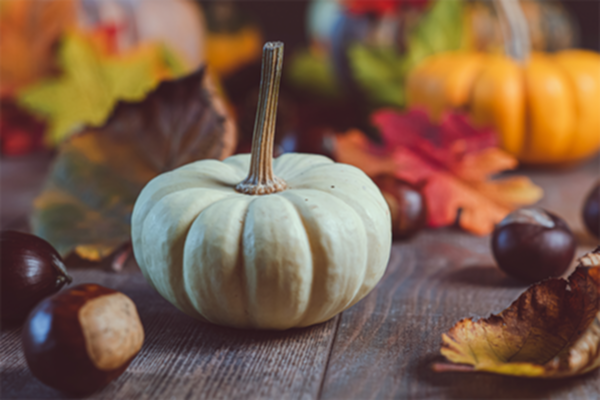The Warmth of Autumn
By Michelle Slowey, MA, RDN, CDCES
The onset of cooler weather brings about thoughts of comfy, rich, sweet, and savory foods for many people. But, can “heavier" foods be healthy? If you indulge in moderation and use portion control, yes, you can eat your fall favorites.
The fall season starts with the sweetest of holidays, Halloween. The key to a healthy Halloween is presentation and moderation. Whether you are dressed in costume to greet trick or treaters, hosting a party, or celebrating the season with festive food for your family, a balance of healthy and fun is all you need.
A light sprinkling of sugar throughout your table can provide festive fun without going overboard. Have a platter of dark chocolate-dipped bananas, strawberries, and apples on your table, serve 4-ounce size green monster smoothies (blend of spinach, apples, bananas, and pineapple) and add googly-candy eyes to float on top.
Clementines make the perfect “tiny pumpkins” to present on a platter. You can draw a pumpkin face with edible markers or cut it into the skin like a jack-o-lantern. Peel a clementine and add a piece of brown licorice as a stem.
Place a small tabletop smoke machine in a witches cauldron to draw your guests to the healthy veggie appetizer table. Get creative with a charcuterie board and arrange raw vegetables, cheese, hummus, pumpkin seed tortilla chips, and apples in the shape of a ghost, skeleton, or jack-o-lantern.
Not only are pumpkins symbolic of the fall season, but they also boast lots of nutrition. Star nutrients are vitamins A, C, and potassium. They supply lots of fiber too. Other winter squash varieties such as acorn, butternut, carnival, delicata, hubbard, lakota, and red kuri squash are also very nutritious. Delicata is a type of winter squash in which the skin is more delicate and is edible. Hubbard squash ranks among the lowest in calories and carbohydrates but is higher in protein and fiber.
Most winter squash can easily be prepared by slicing and roasting. Scoop out the seeds, season with olive oil, rosemary, and a touch of Himalayan salt, and roast in a 400° oven for 20 minutes or until tender. For a sweeter option add a drizzle of maple syrup. Making a yummy soup or a creamy mash is always another delicious option.
When acorn squash is halved it becomes the perfect acorn-shaped cup to fill with ground turkey, broccoli rabe, cranberries, and pine nuts. Another option is stuffing it with quinoa, kale, and parmesan shavings. Roasting with apples and rich fall spices like nutmeg, cinnamon, and sage will make a beautiful side dish. For a spicier dish add herbs like cilantro or curry powder. Adding squash to your favorite chili recipe can bring a bit of sweetness to a cool-weather favorite. For a lighter dish add cubed squash to a spinach and arugula salad with a soft cheese like goat or gorgonzola. Top with walnuts or pecans; it will add just the right amount of crunch to this autumn salad.Here’s one more idea to add to the repertoire - bake the squash seeds and add them to recipes. Many winter squash seeds are rich in magnesium, zinc, calcium, and potassium. Be creative! Dress up your standard holiday recipes with delicious and nutritious winter squash and you will have savory and sweet additions to your holiday table.
Nutrition for 1 cup of each:
Butternut: 63 calories
- 16 carbohydrates
- 3 gms fiber
- 1.4gms protein
- Acorn: 56 calories
- 15 gms carbohydrate
- 2 gms fiber
- 1.1 gm protein
- Delicata: 76 calories
- 18 gms carbohydrates
- 2 gms fiber
- 1.8gms protein
- Hubbard: 46 calories
- 10 gms carbohydrates
- 4.5gms fiber
- 2.3gms protein


